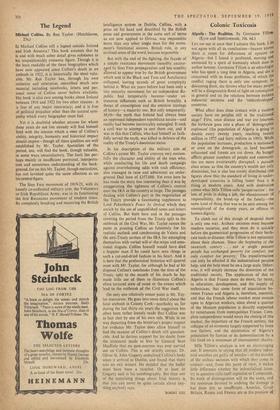The Legend
Is Michael Collins still a legend outside Ireland and Irish America? This book assumes that he is and with much sober detail gives substance to his unquestionably romantic figure. Though it is the least readable of the three biographies which have now appeared since Collins's death in an ambush in 1922, it is historically the most valu- able. Mr. Rex Taylor has, through his own initiative and enterprise, unearthed much new material including notebooks, letters and per- sonal notes of Collins never before available. His book is also rare among books about Ireland between 1916 and 1922 for two other reasons: it is free of any major inaccuracy; and it is free of political prejudice other than the natural sym- pathy which every biographer must feel.
Yet it is doubtful whether anyone for whom these years do not live already will find himself fired with the interest which a man of Collins's ability, integrity, humanity and historical impact should inspire—though all these qualities are well established by Mr. Taylor. Specialists of the period, too, will find the book, though valuable, in some ways unsatisfactory. The fault lies per- haps mainly in insufficient portrayal, interpreta- tion and sometimes understanding of the back- ground, for on this Mr. Taylor, though meticulous, has not lavished quite the same affection as on his central figure.
The Sinn Fein movement of 1919-21, with its loosely co-ordinated military arm, the Volunteers or Irish Republican Army, was in its functioning the first Resistance movement of modern times. By completely breaking and mastering the British
intelligence system in Dublin, Collins, with a price on his head and described by the British press and government in the same sort of terms as are now applied to Grivas, was responsible more than any other single man for the move- ment's functional success. British rule, in any civilised sense of the word, became impossible.
But with the end of the fighting, the façade of a simple resistance movement (sensibly encour- aged by Sinn Fein propagandists and less sensibly allowed to appear true by the British government which sent in the Black and Tans and Auxiliaries) collapsed, leaving strands of great complexity behind it. What six years before had been only a tiny minority movement for an independent Re- public had temporarily become—under ex- traneous influences such as British brutality, a threat of conscription and the emotive stirrings
of history—a majority one. But only temporarily. Myth—the myth that Ireland had always been an oppressed independent republican nation—and reality had become inextricably entangled. It took a civil war to attempt to sort them out, and it was in this that Collins, who had himself so faith- fully served the myth, was killed in defence of the reality of the Treaty's dominion status.
In his description of the military side of Collins's career Mr. Taylor conveys very success- fully the character and ability of the man who, while conducting his life and death campaign against overwhelming odds with such efficiency, also managed to raise and administer an under- ground Dail loan of £357,000. Yet even here he has made the story less interesting than it was by exaggerating the tightness of Collins's control over the IRA in the country at large. The passages dealing with Collins's part in the negotiation of the Treaty provide a fascinating supplement to Lord Pakenham's Peace by Ordeal which they enrich by the use of unpublished notes and letters of Collins. But both here and in the passages covering the period from the Treaty split to the outbreak of the Civil War, Mr. Taylor misses the point in praising Collins so fulsomely for his realistic outlook and condemning de Valera and the anti-Treaty section of the IRA for entangling themselves with verbal will-o'-the-wisps and emo- tional slogans. Collins himself would have died a happier man if he could have seen things in such a cut-and-dried fashion in his heart. And it is here that the professional historian will quarrel most with Mr. Taylor, for although he had at his disposal Collins's notebooks from the time of the Treaty split to the month of his death he has made little use of them to illuminate Collins's often tortured state of mind or the events which lead to the outbreak of the Civil War itself.
On only one relatively minor point is Mr. Tay- lor inaccurate. He goes into some detail about the fatal ambush in County Cork—justifiably so, for during the last thirty-six years the suggestion has often been rather loosely made that Collins was in fact shot by one of his own side. While in no way departing from the historian's proper respect for evidence Mr. Taylor does allow himself to find the manner of Collins's death still question- able. And he derives support for his doubt from the statement made to him by General Sean MacEoin that no post-mortem was ever carried out on Collins. This is not strictly correct. Dr. Oliver St. John Gogarty embalmed Collins's body when it arrived in Dublin, and found that there was no exit wound. He decided that the bullet must have been a ricochet. Or at least so Gogarty said in his autobiography. But•then one of the tantalising things about Irish history is that you can never be quite certain about any- thing anybody says.
ROBERT KEE


































 Previous page
Previous page